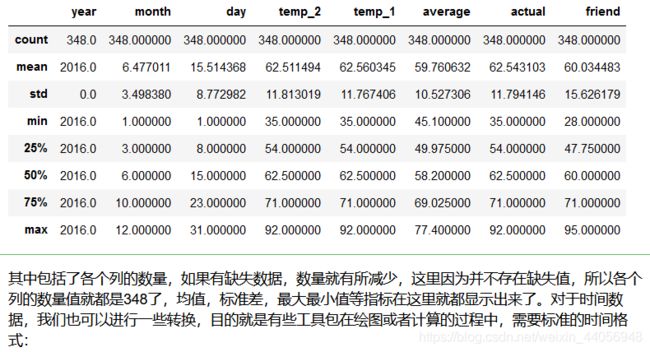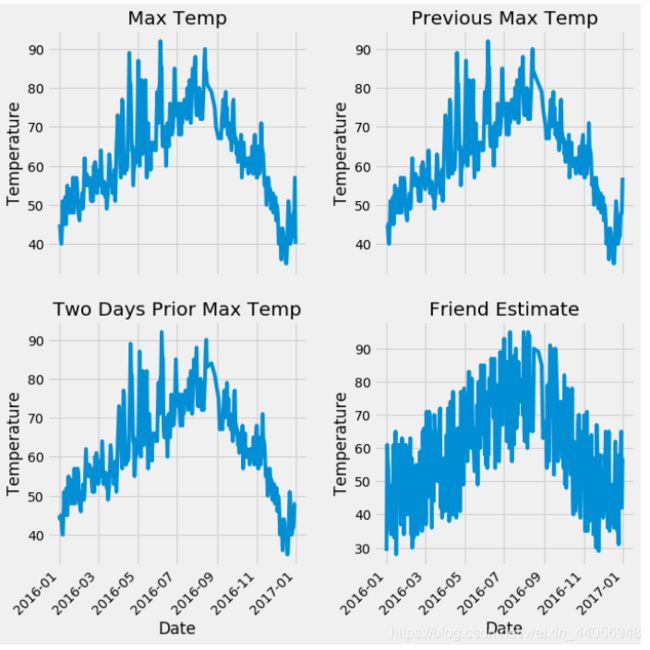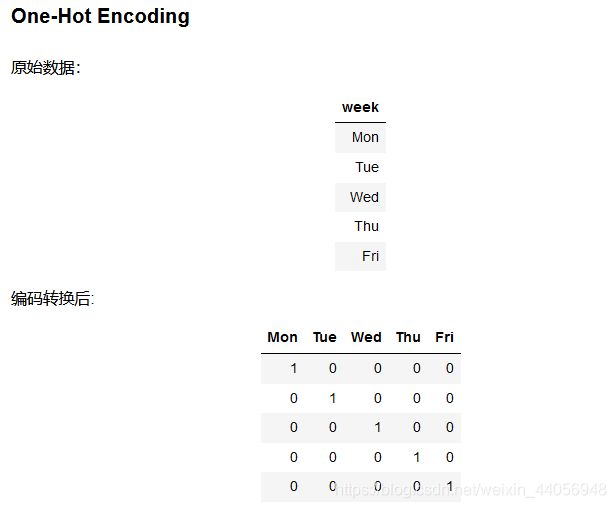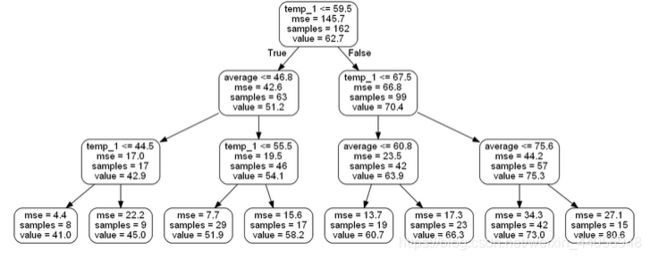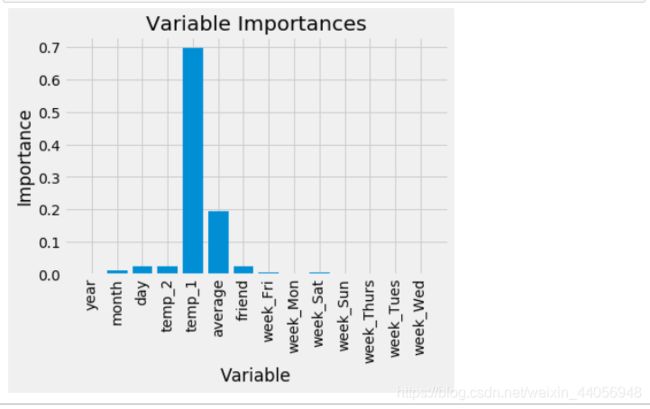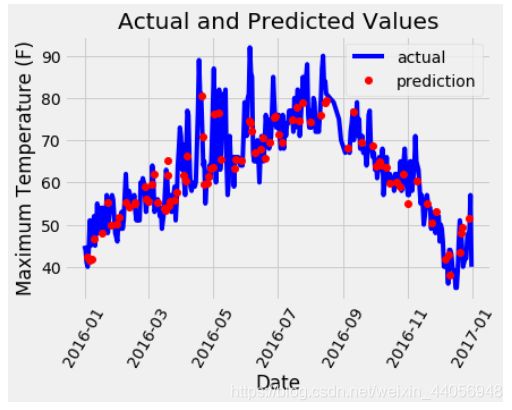Python 机器学习 随机森林 天气最高温度预测任务(一)
我们要完成三项任务:
- 使用随机森林算法完成基本建模任务
基本任务需要我们处理数据,观察特征,完成建模并进行可视化展示分析
- 观察数据量与特征个数对结果影响
在保证算法一致的前提下,加大数据个数,观察结果变换。重新考虑特征工程,引入新特征后观察结果走势。
- 对随机森林算法进行调参,找到最合适的参数
掌握机器学习中两种经典调参方法,对当前模型进行调节
# 数据读取 import pandas as pd features = pd.read_csv('data/temps.csv') features.head(5)
数据表中
- year,moth,day,week分别表示的具体的时间
- temp_2:前天的最高温度值
- temp_1:昨天的最高温度值
- average:在历史中,每年这一天的平均最高温度值
- actual:这就是我们的标签值了,当天的真实最高温度
- friend:这一列可能是凑热闹的,你的朋友猜测的可能值,咱们不管它就好了
数据大小
print('The shape of our features is:', features.shape) # 统计指标 features.describe()
# 处理时间数据 import datetime # 分别得到年,月,日 years = features['year'] months = features['month'] days = features['day'] # datetime格式 dates = [str(int(year)) + '-' + str(int(month)) + '-' + str(int(day)) for year, month, day in zip(years, months, days)] dates = [datetime.datetime.strptime(date, '%Y-%m-%d') for date in dates]
数据展示
# 准备画图 import matplotlib.pyplot as plt %matplotlib inline # 指定默认风格 plt.style.use('fivethirtyeight') # 设置布局 fig, ((ax1, ax2), (ax3, ax4)) = plt.subplots(nrows=2, ncols=2, figsize = (10,10)) fig.autofmt_xdate(rotation = 45) # 标签值 ax1.plot(dates, features['actual']) ax1.set_xlabel(''); ax1.set_ylabel('Temperature'); ax1.set_title('Max Temp') # 昨天 ax2.plot(dates, features['temp_1']) ax2.set_xlabel(''); ax2.set_ylabel('Temperature'); ax2.set_title('Previous Max Temp') # 前天 ax3.plot(dates, features['temp_2']) ax3.set_xlabel('Date'); ax3.set_ylabel('Temperature'); ax3.set_title('Two Days Prior Max Temp') # 我的逗逼朋友 ax4.plot(dates, features['friend']) ax4.set_xlabel('Date'); ax4.set_ylabel('Temperature'); ax4.set_title('Friend Estimate') plt.tight_layout(pad=2)
各项指标看起来都还算正常,由于是国外的天气数据所以跟咱们的统计标准有些区别。接下来就要考虑数据预处理问题了,原始数据中在week列中并不是一些数值特征,而是表示周几的字符串,这些计算机可不认识,需要我们来转换一下:
数据预处理
# 独热编码 features = pd.get_dummies(features) features.head(5)
这样就完成了数据集中属性值的预处理工作,默认会把所有属性值都转换成独热编码的格式,并且还帮我们自动添加了后缀看起来更清晰了,这里我们其实也可以按照自己的方式来设置编码特征的名字的,如果大家遇到了一个不太熟悉的函数,想看一下其中的细节,有一个更直接的方法就是在notebook当中直接调help工具来看一下它的API文档,下面返回的就是其细节介绍,不光有各个参数说明,还有一些小例子,建议大家在使用的过程中一定要养成多练多查的习惯,查找解决问题的方法也是一个很重要的技能:
标签与数据格式转换
# 数据与标签 import numpy as np # 标签 labels = np.array(features['actual']) # 在特征中去掉标签 features= features.drop('actual', axis = 1) # 名字单独保存一下,以备后患 feature_list = list(features.columns) # 转换成合适的格式 features = np.array(features)
训练集与测试集
# 数据集切分 from sklearn.model_selection import train_test_split train_features, test_features, train_labels, test_labels = train_test_split(features, labels, test_size = 0.25, random_state = 42)
建立一个基础的随机森林模型
# 导入算法 from sklearn.ensemble import RandomForestRegressor # 建模 rf = RandomForestRegressor(n_estimators= 1000, random_state=42) # 训练 rf.fit(train_features, train_labels)
由于数据样本量还是非常小的,所以很快就可以得到结果了,这里我们先用MAPE指标来进行评估,也就是平均绝对百分误差,其实对于回归任务,评估方法还是比较多,给大家列出来几种,很简单就可以实现出来,也可以选择其他指标来进行评估:
# 预测结果 predictions = rf.predict(test_features) # 计算误差 errors = abs(predictions - test_labels) # mean absolute percentage error (MAPE) mape = 100 * (errors / test_labels) print ('MAPE:',np.mean(mape))
MAPE指标
可视化展示树
# 导入所需工具包 from sklearn.tree import export_graphviz import pydot #pip install pydot # 拿到其中的一棵树 tree = rf.estimators_[5] # 导出成dot文件 export_graphviz(tree, out_file = 'tree.dot', feature_names = feature_list, rounded = True, precision = 1) # 绘图 (graph, ) = pydot.graph_from_dot_file('tree.dot') # 展示 graph.write_png('tree.png'); print('The depth of this tree is:', tree.tree_.max_depth) # 限制一下树模型 rf_small = RandomForestRegressor(n_estimators=10, max_depth = 3, random_state=42) rf_small.fit(train_features, train_labels) # 提取一颗树 tree_small = rf_small.estimators_[5] # 保存 export_graphviz(tree_small, out_file = 'small_tree.dot', feature_names = feature_list, rounded = True, precision = 1) (graph, ) = pydot.graph_from_dot_file('small_tree.dot') graph.write_png('small_tree.png');
特征重要性
# 得到特征重要性 importances = list(rf.feature_importances_) # 转换格式 feature_importances = [(feature, round(importance, 2)) for feature, importance in zip(feature_list, importances)] # 排序 feature_importances = sorted(feature_importances, key = lambda x: x[1], reverse = True) # 对应进行打印 [print('Variable: {:20} Importance: {}'.format(*pair)) for pair in feature_importances]
用最重要的特征再来试试
# 选择最重要的那两个特征来试一试 rf_most_important = RandomForestRegressor(n_estimators= 1000, random_state=42) # 拿到这俩特征 important_indices = [feature_list.index('temp_1'), feature_list.index('average')] train_important = train_features[:, important_indices] test_important = test_features[:, important_indices] # 重新训练模型 rf_most_important.fit(train_important, train_labels) # 预测结果 predictions = rf_most_important.predict(test_important) errors = abs(predictions - test_labels) # 评估结果 mape = np.mean(100 * (errors / test_labels)) print('mape:', mape) # 转换成list格式 x_values = list(range(len(importances))) # 绘图 plt.bar(x_values, importances, orientation = 'vertical') # x轴名字 plt.xticks(x_values, feature_list, rotation='vertical') # 图名 plt.ylabel('Importance'); plt.xlabel('Variable'); plt.title('Variable Importances');
预测值与真实值之间的差异
# 日期数据 months = features[:, feature_list.index('month')] days = features[:, feature_list.index('day')] years = features[:, feature_list.index('year')] # 转换日期格式 dates = [str(int(year)) + '-' + str(int(month)) + '-' + str(int(day)) for year, month, day in zip(years, months, days)] dates = [datetime.datetime.strptime(date, '%Y-%m-%d') for date in dates] # 创建一个表格来存日期和其对应的标签数值 true_data = pd.DataFrame(data = {'date': dates, 'actual': labels}) # 同理,再创建一个来存日期和其对应的模型预测值 months = test_features[:, feature_list.index('month')] days = test_features[:, feature_list.index('day')] years = test_features[:, feature_list.index('year')] test_dates = [str(int(year)) + '-' + str(int(month)) + '-' + str(int(day)) for year, month, day in zip(years, months, days)] test_dates = [datetime.datetime.strptime(date, '%Y-%m-%d') for date in test_dates] predictions_data = pd.DataFrame(data = {'date': test_dates, 'prediction': predictions}) # 真实值 plt.plot(true_data['date'], true_data['actual'], 'b-', label = 'actual') # 预测值 plt.plot(predictions_data['date'], predictions_data['prediction'], 'ro', label = 'prediction') plt.xticks(rotation = '60'); plt.legend() # 图名 plt.xlabel('Date'); plt.ylabel('Maximum Temperature (F)'); plt.title('Actual and Predicted Values');
看起来还可以,这个走势我们的模型已经基本能够掌握了,接下来我们要再深入到数据中了,考虑几个问题: 1.如果可以利用的数据量增大,会对结果产生什么影响呢? 2.加入新的特征会改进模型效果吗?此时的时间效率又会怎样?

